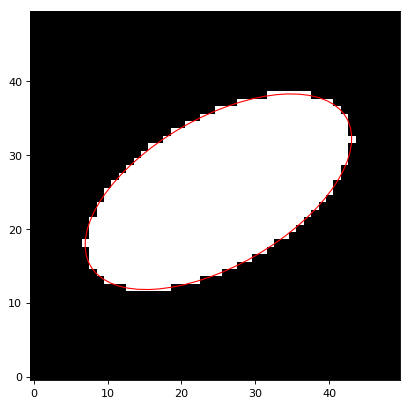Ellipse2D¶
-
class
astropy.modeling.functional_models.Ellipse2D(amplitude=1, x_0=0, y_0=0, a=1, b=1, theta=0, **kwargs)[source] [edit on github]¶ Bases:
astropy.modeling.Fittable2DModelA 2D Ellipse model.
Parameters: - amplitude : float
Value of the ellipse.
- x_0 : float
x position of the center of the disk.
- y_0 : float
y position of the center of the disk.
- a : float
The length of the semimajor axis.
- b : float
The length of the semiminor axis.
- theta : float
The rotation angle in radians of the semimajor axis. The rotation angle increases counterclockwise from the positive x axis.
Other Parameters: - fixed : a dict, optional
A dictionary
{parameter_name: boolean}of parameters to not be varied during fitting. True means the parameter is held fixed. Alternatively thefixedproperty of a parameter may be used.- tied : dict, optional
A dictionary
{parameter_name: callable}of parameters which are linked to some other parameter. The dictionary values are callables providing the linking relationship. Alternatively thetiedproperty of a parameter may be used.- bounds : dict, optional
A dictionary
{parameter_name: value}of lower and upper bounds of parameters. Keys are parameter names. Values are a list or a tuple of length 2 giving the desired range for the parameter. Alternatively, theminandmaxproperties of a parameter may be used.- eqcons : list, optional
A list of functions of length
nsuch thateqcons[j](x0,*args) == 0.0in a successfully optimized problem.- ineqcons : list, optional
A list of functions of length
nsuch thatieqcons[j](x0,*args) >= 0.0is a successfully optimized problem.
Notes
Model formula:
\[\begin{split}f(x, y) = \left \{ \begin{array}{ll} \mathrm{amplitude} & : \left[\frac{(x - x_0) \cos \theta + (y - y_0) \sin \theta}{a}\right]^2 + \left[\frac{-(x - x_0) \sin \theta + (y - y_0) \cos \theta}{b}\right]^2 \leq 1 \\ 0 & : \mathrm{otherwise} \end{array} \right.\end{split}\]Examples
import numpy as np from astropy.modeling.models import Ellipse2D from astropy.coordinates import Angle import matplotlib.pyplot as plt import matplotlib.patches as mpatches x0, y0 = 25, 25 a, b = 20, 10 theta = Angle(30, 'deg') e = Ellipse2D(amplitude=100., x_0=x0, y_0=y0, a=a, b=b, theta=theta.radian) y, x = np.mgrid[0:50, 0:50] fig, ax = plt.subplots(1, 1) ax.imshow(e(x, y), origin='lower', interpolation='none', cmap='Greys_r') e2 = mpatches.Ellipse((x0, y0), 2*a, 2*b, theta.degree, edgecolor='red', facecolor='none') ax.add_patch(e2) plt.show()
()

Attributes Summary
aamplitudebinput_unitsThis property is used to indicate what units or sets of units the evaluate method expects, and returns a dictionary mapping inputs to units (or Noneif any units are accepted).param_namesthetax_0y_0Methods Summary
evaluate(x, y, amplitude, x_0, y_0, a, b, theta)Two dimensional Ellipse model function. Attributes Documentation
-
a¶
-
amplitude¶
-
b¶
-
input_units¶ This property is used to indicate what units or sets of units the evaluate method expects, and returns a dictionary mapping inputs to units (or
Noneif any units are accepted).Model sub-classes can also use function annotations in evaluate to indicate valid input units, in which case this property should not be overridden since it will return the input units based on the annotations.
-
param_names= ('amplitude', 'x_0', 'y_0', 'a', 'b', 'theta')¶
-
theta¶
-
x_0¶
-
y_0¶
Methods Documentation
-
static
evaluate(x, y, amplitude, x_0, y_0, a, b, theta)[source] [edit on github]¶ Two dimensional Ellipse model function.